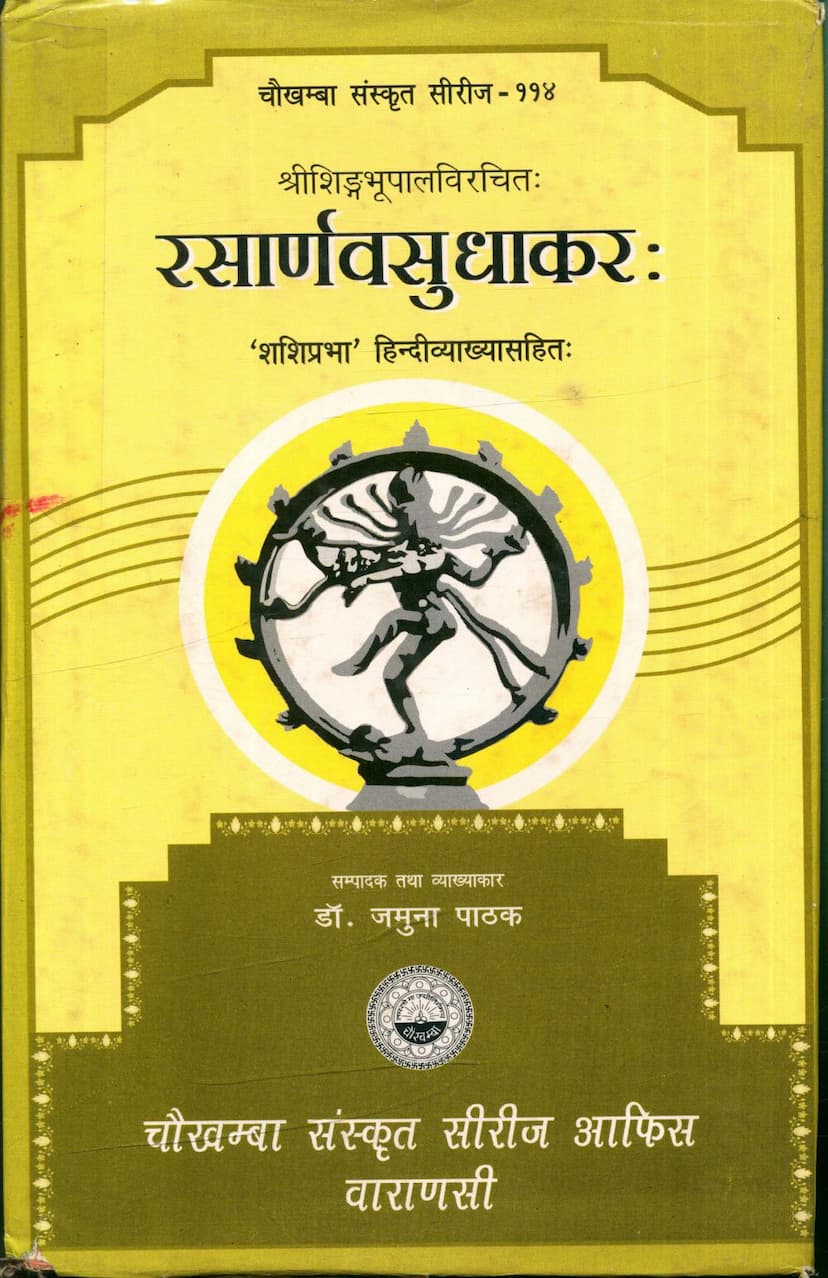Rasarnavsudhakar
Added to library: September 2, 2025

Summary
Rasarnavasudhakara by Singhbupal: A Comprehensive Summary
Title: Rasarnavasudhakara Author: Singhbupal Publisher: Chowkhamba Sanskrit Series (Series No. 114) Editor & Commentator: Dr. Jamuna Pathak
Overview:
The Rasarnavasudhakara, authored by the learned king Singhbupal, is a significant and comprehensive treatise on the ancient Indian art of dramaturgy (Natya Shastra). It meticulously elaborates on various aspects of Sanskrit drama, offering a systematic and detailed exposition of its creative, aesthetic, and practical elements. The text is structured into three "Vilasas" (sections) and is primarily presented in the form of "Karika" (short verses), interspersed with prose for clarity and explanation.
Key Features and Content:
The Rasarnavasudhakara is highly valued for its:
- Comprehensive Coverage of Dramatic Elements: The work delves into a wide spectrum of topics related to Sanskrit drama, including:
- Dramatic Structure and Composition: It details the ten types of dramas (Dasa Bhedas), plot construction (Katha-vastu) and its various classifications, dramatic divisions (Sandhi), sub-divisions of divisions (Sandhyanga), plot-seeds (Artha-prakriti), embellishments (Bhushana), and intermediate parts of divisions (Sandhyantara).
- Aesthetics and Rasa Theory: A significant portion is dedicated to the theory of Rasa (aesthetic sentiment), discussing Vibhava (determinants), Anubhava (consequents), and Vyabhichari-bhavas (transitory emotions). The author critically analyzes and judiciously accepts various prevalent theories, discarding inconsistent ones.
- Character Delineation: The text provides detailed descriptions of various character types, including noble heroes (Uttama-adi Nayaka) and their classifications (Dhirodatta, Dhiralalita, Dhirashanta, Dhiroddhatta), their assistants, heroines (Nayika) and their various classifications (Swakiya, Parakiya, Samanya), their stages of love (Avastha), and their attendants.
- Literary and Stylistic Aspects: It covers aspects of poetic language, including different styles (Riti), the origin of dramatic techniques (Vritti), and the classification of languages and dialects (Bhasha, Vibhasha).
- Practical Aspects (Limited): While the focus is primarily on the creative and aesthetic aspects, there are occasional, albeit minimal, references to practical elements like acting (Abhinaya), dialogue (Samvad), costumes (Veshbhusha), and stage decoration (Rangamancha-sajja).
- Extensive Use of Examples: A notable feature of the Rasarnavasudhakara is its generous use of examples to clarify the discussed principles. These examples are drawn from a vast repository of Sanskrit literature, with some even being original compositions by the author.
- Originality and Contribution: While the author upholds the tradition of preceding scholars in dramaturgy, Singhbupal also incorporates significant changes, elaborations, and original insights, making the work a valuable contribution to the field.
- Clarity and Structure: The text is praised for its systematic organization and the clarity with which the author presents complex concepts. The use of both verse and prose aids in the comprehension of the subject matter.
- Influence: The Rasarnavasudhakara has served as an inspiration for subsequent playwrights and scholars of Natya Shastra.
Author's Background (Singhbupal):
The Rasarnavasudhakara also provides insights into its author, Singhbupal. He is described as a king, a patron of arts and sciences, and a scholar with a deep understanding of grammar, literature, rhetoric, and dramaturgy. His personal verses, often quoted as examples, reveal his mastery of poetic expression, particularly in depicting the nuances of feminine emotions and character. The preface also highlights his critique of earlier scholars' works, demonstrating his critical acumen and independent thinking. His reign extended from Shri Shaila to the Vindhya mountains, indicating a significant territorial dominion. The compiler, Dr. Jamuna Pathak, has provided a comprehensive Hindi commentary titled 'Shashiprabha' to make this valuable text accessible to a wider audience.
Significance:
The Rasarnavasudhakara is considered an important work for understanding the theoretical and aesthetic foundations of Sanskrit drama. Its detailed analysis of various dramatic components and its balanced approach to scholarly discourse make it an indispensable resource for students and researchers of Indian theatre and literature. The text's contribution lies not only in its compilation of existing knowledge but also in its critical engagement with and expansion upon those traditions.